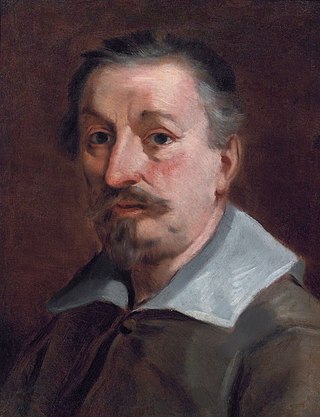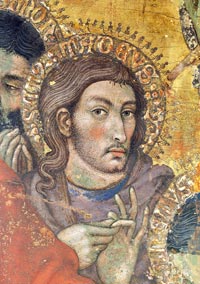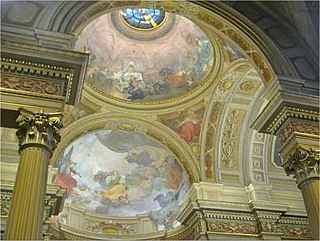
Filippino Lippi was an Italian painter working in Florence, Italy during the later years of the Early Renaissance and first few years of the High Renaissance.

Francesco Albani or Albano was an Italian Baroque painter who was active in Bologna (1591–1600), Rome (1600–1609), Bologna (1609), Viterbo (1609–1610), Bologna (1610), Rome (1610–1617), Bologna (1618–1660), Mantova (1621–1622), Roma (1623–1625) and Florence (1633).

Lorenzo di Credi was an Italian Renaissance painter and sculptor best known for his paintings of religious subjects. He is most famous for having worked in the studio of Andrea del Verrocchio at the same time as the young Leonardo da Vinci.

Francesco del Cossa was an Italian Renaissance painter of the School of Ferrara, who after 1470 worked in Bologna. Cossa is best known for his frescoes, especially his collaboration with Cosimo Tura on a cycle of the months in the Palazzo Schifanoia of the Este family, rulers of Ferrara. Otherwise, his paintings are mostly of religious subjects, with some portraits and drawings attributed to him. He also designed stained glass.
Andrea Solari (1460–1524) was an Italian Renaissance painter of the Milanese school. He was initially named Andre del Gobbo, but more confusingly as Andrea del Bartolo a name shared with two other Italian painters, the 14th-century Siennese Andrea di Bartolo, and the 15th-century Florentine Andrea di Bartolo.

Taddeo di Bartolo, also known as Taddeo Bartoli, was an Italian painter of the Sienese School during the early Renaissance. His biography appears in the Vite of Giorgio Vasari, who claims that Taddeo was the uncle of Domenico di Bartolo.

Sant'Anna dei Lombardi,, and also known as Santa Maria di Monte Oliveto, is an ancient church and convent located in piazza Monteoliveto in central Naples, Italy. Across Monteoliveto street from the Fountain in the square is the Renaissance palace of Orsini di Gravina.

Giovanni Antonio Boltraffio was an Italian painter of the High Renaissance from Lombardy, who worked in the studio of Leonardo da Vinci. Boltraffio and Bernardino Luini are the strongest artistic personalities to emerge from Leonardo's studio. According to Giorgio Vasari, he was of an aristocratic family and was born in Milan.
The decade of the 1460s in art involved some significant events.
Francesco Nasini was an Italian painter of the Baroque period, active mainly in towns outside of Siena, Italy.

The Leonardeschi were the large group of artists who worked in the studio of, or under the influence of, Leonardo da Vinci. They were artists of Italian Renaissance painting, although his influence extended to many countries within Europe.
The Catalogue of paintings in the National Gallery, London is the collection catalog listing the paintings of the National Gallery, London collection, as they were catalogued in 2010 by the Public Catalogue Foundation. The collection contains roughly 2,300 paintings by 750 artists, and only attributed artists are listed here. Painters with more than twenty works in the collection are Jean-Baptiste-Camille Corot, Carlo Crivelli, Anthony van Dyck, Francesco Guardi, Rembrandt van Rijn, Peter Paul Rubens, Jacob van Ruisdael, and David Teniers II. The only women artists with works in the collection are Artemisia Gentileschi, Marie Blancour, Rosa Bonheur, Rosalba Giovanna Carriera, Catharina van Hemessen, Judith Leyster, Rachel Ruysch, and Elisabeth Louise Vigée-LeBrun. The only British artists with works in the collection are William Boxall, John Constable, Thomas Gainsborough, William Hogarth, John Hoppner, John Callcott Horsley, John Jackson, Thomas Jones, Cornelis Janssens van Ceulen, Thomas Lawrence, John Linnell, Henry Raeburn, Joshua Reynolds, Martin Archer Shee, George Stubbs, Joseph Mallord William Turner, Richard Wilson, and Joseph Wright of Derby. However, because of the historical links between the National Gallery and its offshoot in the 19th century, Tate Britain, the National has in the past transferred and recalled works by British artists to and from its collection.

The church of Santa Maria Maddalena is found in central Bologna, Italy.

Museo Civico di Teramo is an art museum in Teramo, Abruzzo.

Giovanni Battista Ramenghi was an Italian painter. He is sometimes known as Bagnacavallo junior or Bagnacavallo the Younger to distinguish him from his father Bartolomeo Ramenghi.
Sant'Anna is Roman Catholic church in the municipality of Sessa Aurunca, province of Caserta, Campania, southern Italy. The church, dedicated to St Anne, lies in front of Piazza Tiberio in the historic central district of the town.

The Museo della Città is the civic museum located in the former Jesuit convent on Via Luigi Tonini #1 of the city of Rimini, in the region of Emilia-Romagna, Italy. It rises adjacent to Chiesa del Suffragio, and a modern structure built to enclose the ruins of an ancient Roman Domus, or house.














